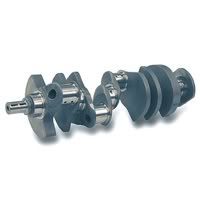Hi Steve,
I started out making steam engines, most notably Stuart engines. These came with a forged blank for the crank. I also purchased a book on how to machine the Stuart engines which explained how to machine the crank. I have done single and double throw Stuart cranks.
With this in mind when I started building hit & miss engines I made one piece cranks. Usually they were made from CRS. The all warped to some degree but usually with small repetitive cuts I could get them trued up. One particular crank just wouldn't cooperate so I made a segmented crank. I made the two cheeks and drilled and reamed them at the same time so the center distances would be identical. I then slid the drill rod pieces through the holes (.0005-.001 clearance) enough gap to get the silver solder to fill in. After it was soldered I cut out the center bar, mounted the crank between centers and indicated it. It was close and saveable but not perfect out of the box.
When I made the crank for my V-8 I was initially daunted by the idea of having to turn the offset throws so I went for a built up crank. Because of the configuration I made the mains with their corresponding web pieces out of one piece of stock. When I got them turned I made up a jig so that all the throw holes would be identical. I then made up shouldered crank pins and started assembling the crank. I then made up a fixture to mount the crank into for soldering. It resembled the bottom of the block with clamps to hold the mains in place. I also used this fixture to true up the crank as I was assembling it. I would rotate the crank and indicate it, pull it out twist and tweak, put it back in and re-indicate. After much time of adjusting, twisting and indicating I got it to where I thought it should be, clamped it down and silver soldered it. When I unbolted it and re-indicated it it was close, farthest dimension was .004 as I recall. Having spent hours and hours of making the parts, assembling, indicating, adjusting and what-have-you I was bent on making this thing work so I started tweaking and bending it between centers countless times to get it true. I believe I ended up with .0015 overall.
At the time I only had my small lathe, 6 incher, so this was pretty much my only option. After that I got a 9 inch South Bend and remade the crank as a one piece unit. When I turned it I left a little bit of stock on the mains and throws, .002, and I made up a toolpost grinder to finish them off. That crank finished up at around .0005 overall.
So to get to the point of my story, I realize that everyone has different skill levels and equipment options but if I had my druthers I would make a one piece crank every time. Don't get me wrong, I'm not saying that a multi-piece crank can't work it's just that the amount of time that goes into it can far exceed the time it takes to make a solid crank.
George

















































